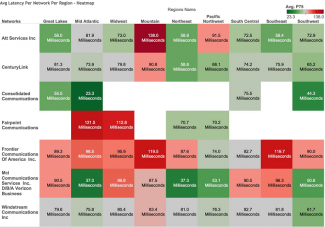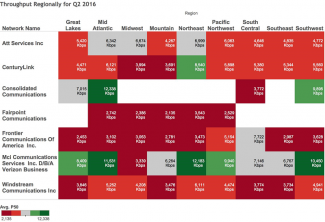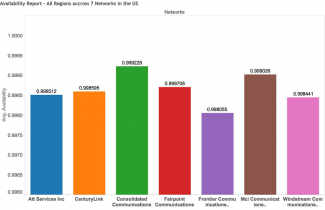How do top U.S. carriers like AT&T, Consolidated Communications and Verizon compare when it comes to wireline network throughput, latency and availability? These three factors have a direct impact on how well operators serve businesses and consumers, making it important for customers to know what they're getting.
Below you'll find charts showing exactly how these service providers stacked up against each other in the second quarter across their respective networks.
Also, make sure to check out our first-quarter 2016, fourth-quarter 2015 and third-quarter 2015 network performance reports.
Network throughput:
The Northeast appears to have the best throughput overall in the U.S. at the 50th percentile, but interestingly not at the 75th percentile. At 8.44 and 8.25 Mbps, Verizon and Consolidated continued to hold the title of having the best throughput within the Northeast region. However, Consolidated is only present in four states.
AT&T and CenturyLink had 5.5 Mbps and 5.54 Mbps took the middle point, rising from 5.1 and 5.18 Mbps in the first quarter.
Rounding out the lower end of the group were FairPoint, Frontier and Windstream. FairPoint and Frontier had 2.66 and 3.87 Mbps, while Windstream remained at the top 4.45 Mbps.
While Windstream and Frontier improved throughput over the 3.9 Mbps and 2.87 Mbps they had in the first quarter, FairPoint dropped from 3.19 Mbps.

Network latency:
Latency, which is typically measured in milliseconds, is defined as the time it takes for a source to send a packet of data to a receiver. The lower the latency (the fewer the milliseconds), the better the network performance is for the user.
Cedexis included the 50th and 75th percentile to illustrate service providers that had poor network performance.
On a regional basis, the Southwest and Northeast have the overall best latency across the top seven networks, while the Mountain region and Midwest run at close the twice the average latency.
In this quarter, Cedexis exposed the Northeast region at the state level. On average, Connecticut appears to have the best performance across these seven networks.
Verizon again topped the low network latency scales at 37.9 milliseconds, followed by Consolidated with 49.4 milliseconds. However, both telcos’ latency was slightly higher than the 39.7 and 39.8 milliseconds, respectively, which was reported in the first quarter.
Hitting the middle rankings were CenturyLink and AT&T with 58.0 and 59.1 milliseconds. AT&T and CenturyLink’s latency rankings were up from the 44.9 milliseconds and 48.3 milliseconds the two carriers saw in the first quarter.
Rounding out the group were FairPoint, Frontier, and Windstream, which saw their latency numbers jump to 93.8, 86.2 and 77.8 milliseconds, respectively. What’s interesting is that FairPoint and Windstream saw their latency rankings rise significantly over the 55 and 52.8 milliseconds that were reported the previous quarter.

Network availability:
Cedexis measured network availability as a percentage of connection attempts. Similar to latency and throughput, service provider performance in this category varied.
A key goal of all traditional wireline providers is to achieve what is known as five nines availability, something that carriers strive for but never can consistently reach.
The research firm noted that many providers had three nines of performance, but there were some exceptions regionally.
Again, Verizon and Consolidated had the top network availability with .9990 and .9998 percent of network availability. AT&T and CenturyLink were nearly with tied over two nines of availability at .9985 and .9986 percent.
Finally, FairPoint and Frontier showed availability of .9980 and .9981, while Windstream clocked in slightly with nearly three nines at .9984 percent.
In comparison, FairPoint and Frontier had .997 percent and .998 percent of availability respectively in the first quarter, but FairPoint was only measured in four states. Likewise, Windstream saw .998 percent across its wireline operating territories.

Stay tuned for the next quarter, when FierceTelecom and Cedexis team up again to measure network performance.
